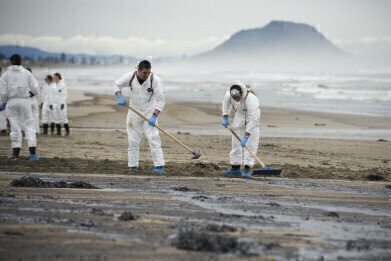Fuel for Thought
Tracking the 2015 California Oil Spill Clean Up
Jun 26 2015
The sunny shores of California were turned into an environmental nightmare last month when a catastrophic spill saw 105,000 gallons of oil spewed out into the Pacific Ocean. The slick quickly infiltrated Refugio state beach, with environmental activists maintaining that the viscous liquid is now sullying the rare coastal ecosystems of the Gaviota coast. There are only five of the unique Mediterranean-climate regions on the planet and this one could be shut down for months to come.
What caused the spill?
In this instance, Houston-based company Plains All-American Pipeline is the culprit behind the spill. On Wednesday May 19 one of its pipelines cracked open and churned out no less than 105,000 gallons of crude oil. The spill blackened Refugio state beach, with an estimated 21,000 gallons of oil thought to have made it to the ocean.
Darren Palmer, chairman and CEO of Plains All-American Pipeline admits that while the exact cause of the leak has not yet been identified, the company suspects that it may have been caused by “mechanical issues” with its pumping units. “We deeply regret that this incident has occurred at all,” says Palmer. “We apologise for the damage it has done to the environment. We apologise to the residents and visitors for the inconvenience it has caused, especially on this Memorial Day weekend.”
Operation: Oil spill clean-up!
So what’s being done to clean up after Plains All-American Pipeline? Over the past few weeks a team of Shoreline Cleanup Assessment Technique trained members have been evaluating the extent of the oil coverage and developing both short and long-term plans of action. At the peak of the clean-up efforts over 1,200 individuals were involved on a daily basis. This involved on-foot teams, as well as patrolling aeroplanes, helicopters and boats. To date around 76% of the affected coastline has been purged, yet there is still a long way to go.
Wildlife warriors
One of the biggest threats of the oil spill is to local wildlife. Environmentalists are out in full force to help minimise the risks and clean-up any animals that have found themselves unnaturally greasy. As of last week 106 animals has been found coated in oil and were sent to rehabilitation clinics.
Scouring rocks and beaches
Another major clean-up project is the scouring of oil blackened rocks in the area. The California Department of Fish and Wildlife and the Coast Guard are leading this particular clean-up movement and is relying on local volunteers to help fast-track the oil onslaught.
A multi-million dollar clean-up
Unfortunately, clean-up efforts don’t come cheap. Already the state has spent over US$69 million on the efforts, with more expenses still being incurred every day.
Oil and the ocean simply don't go hand in hand, and any project transporting petroleum should have stringent safety measures in place. Find out more about how rigs manage risks in this article, Different Technlogy Options for Monitoring Oil Produced in Water - Inline Continuous Monitoring and IR ANalysis.
Image via Wikipedia
Digital Edition
PIN 25.2 Apr/May
April 2024
In this Edition Safety - Carbon monoxide toxic and flammable gas detection Analytical Instrumentation - Density: A fundamental parameter at critical stages within the petroleum sector...
View all digital editions
Events
May 05 2024 Seville, Spain
May 06 2024 Riyadh, Saudi Arabia
May 06 2024 Houston, Tx, USA
May 06 2024 Houston, Tx, USA
Canada Gas & LNG Exhibition & Conference
May 07 2024 Vancouver, BC, Canada


















